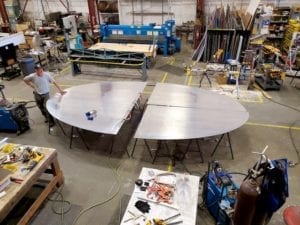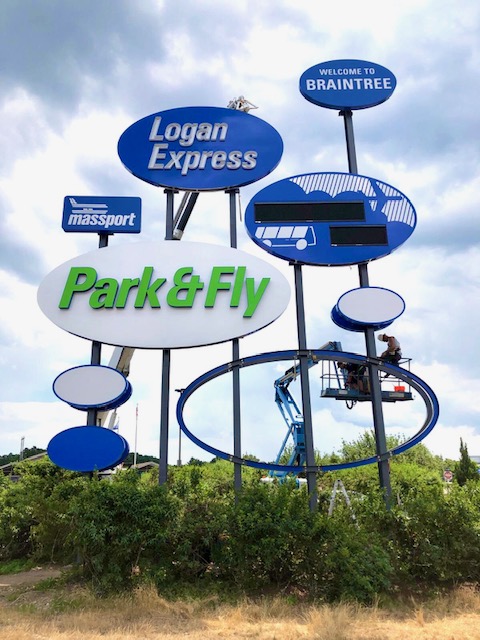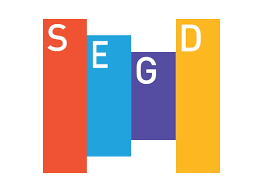The Massport Sign at the Braintree Split: Delivered with Speedy Professionalism
Design/Build, Digital Signage, Electronic Message Centers (EMC), Exterior Signage, Functional Signage, Partners-Developers-Contractors, Sign Design, Sign Renovation, Signage TipsThree major highways — Interstate 93, U.S. Route 1, and Route 3 — converge at the Braintree Split. Just 10 miles south of Boston’s Logan International Airport, it’s also home to Massport’s Logan Express, a shuttle bus with a commuter parking lot: The Logan Express Park & Fly.
Until recently, however, the sign that advertised this commuter lot badly needed replacing. Rusted and broken, with burnt-out bulbs, the old sign did nothing to call attention to this critical business.
The refurbishment of this high profile sign was a key objective of Massport’s CEO, Lisa Wieland. The Project Management team from Edward Paige Corp reached out to Metro Sign in early March with a request for proposal (RFP). Within a week, Metro’s team submitted its bid. By the end of the month — when Metro learned it had been awarded the contract — the COVID-19 pandemic had also arrived. From the start, Metro was beset with challenges, including a delivery date only three months away, which wasn’t changing in spite of pandemic-caused shutdowns.
While the project’s end client was Massport, the direct client with whom Metro worked was Edward Paige Corporation, a WBE-certified civil engineering company and general contractor.
Together, the Metro and Edward Paige teams partnered on working through the design & engineering approval process, fabrication and installation of the new 18-sign double face pylon sign.
The Challenge of Fast-Tracking Designs and Approvals
Because the companies had three months for the entire project — shop drawing design, engineering, approval obtaining, manufacturing, and sign installation — the timeline moved quickly.
Metro’s VP of Sales and Marketing Tom Dunn explains, “Edward Paige’s submitted the preliminary sketches. We reviewed the drawing packages to find things we’d recommend changing or suggest best ways to manufacture the signs due to the time constraints, budget and availability of certain products as a result of the pandemic . The team of designers making these requests were very familiar with signs and had a clear vision. They know their stuff. We just had to lay out the challenges and work together to find some alternatives to keep the install deadline that was specified.”
Metro used value engineering ideas to keep costs within Massport’s budget. “We proposed things that could be done more quickly because timing was an issue,” Dunn says, “but also because we knew other high quality materials would work and be fabrication-friendly for controlling costs.”
Metro proposed using the Sloan faux neon LED product (LEDStripe, FlexiBrite)that was ⅓ the cost of the original specification. “The proposed product was very nice but would have added a significant increase to the project,” says Dunn. The client ultimately accepted the comparable product Metro recommended after reviewing the production samples. This faux neon option provide the desired effect and will easily be seen from the highway, which is set quite a ways back from the sign.
The whole process of developing and finessing details of a project this scope will often take between six weeks and two months – but Metro and Edward Paige’s collaboration enabled the two companies to fast-track that process. Metro’s shop created samples for approval, but COVID-19 meant no outside visits to the workshop. “We needed to improvise by shipping scaled down product samples along with emailing photos because the deadline was looming and we’d reached the end of April before everything was finalized and approved,” says Dunn.
“We talked to our team and they agreed we could still pull it off with some over-time. They rallied together, worked their magic to manufacture and install the signage on time. It wasn’t an easy process, but everyone was up to the challenge. I was so impressed by their commitment to get it done.” he says.
Good Partnerships Yield Great Results
“Edward Paige was a great partner to work with,” Dunn says. “They were highly responsive to us and to Massport, and had plenty of flexibility. They told us that whatever it took to get done, they’d make sure it happened. It was pretty exciting for us, because we had about six or seven people involved coordinating everything. Elaine Costello was the point person with the client, while Corey Fisher was overseeing the engineering and fabrication details.
“The quarterback for Edward Paige is Rob Schuster. He’s been an unbelievable project manager,” says Dunn. “He was our go-to liaison who made everything happen between the leadership team from Massport,Dewberry and Roll Barressi as well as all the other trades working on the site. Their role in the project included overseeing the signage, electrical, abatement and refurbishment of the posts as well as upgrading the parking lot and landscaping.”
Melissa Pegurri, President and CEO of Edward Paige, says, “I want to share that the Metro team has been FABULOUS to work with. We are all really impressed. Metro definitely gets the gold star of excellence.”
A Massive (and Speedy) Undertaking
 Metro’s entire team worked on the nine sign types, several of which are huge — including a couple 20’ ovals. And while the project includes nine total signs per side, the team had to manufacture 18 different cabinets attached to both sides of the post. And everything was completed and installed in ⅔ of the time a typical project would require. Metro’s lead installer, Eric Dyke, did an amazing job leading the team while coordinating all of his work with several other trades working on the job site.
Metro’s entire team worked on the nine sign types, several of which are huge — including a couple 20’ ovals. And while the project includes nine total signs per side, the team had to manufacture 18 different cabinets attached to both sides of the post. And everything was completed and installed in ⅔ of the time a typical project would require. Metro’s lead installer, Eric Dyke, did an amazing job leading the team while coordinating all of his work with several other trades working on the job site.
The project includes an electronic message center (EMC) sign which ties directly into the Massport system so it can provide updates on departures to the airport and other relevant travel information. Metro teamed with Adaptive Display Solutions for that particular element to ensure that everything aligned accurately and worked perfectly.
Once again, Metro lived up to its commitment to get the work done professionally and well. Metro completed the Massport signage — originally estimated to be a 12 week fabrication project — in just eight weeks. While a difficult challenge even in the best of times, adding the monkey wrench of a tight timeline during a pandemic required a massive team effort to complete it on time.

